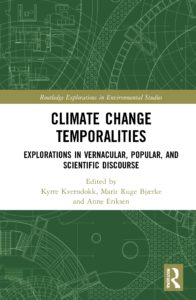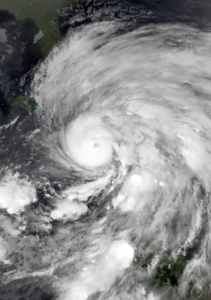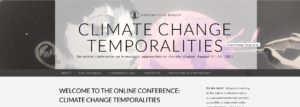Welcome to the conference Climate change temporalities: Narratives, Representations and Practices. We are looking forward to three days of presentations, discussions and exchange of ideas from August 11 to August 13. This is the webpage for the conference, including all the information about the event. https://climatechange.w.uib.no/
Author Archives: Kyrre Kverndokk
Update about the conference Climate Change Temporalities
After careful consideration of the world’s current circumstances and our hopes and sober expectations for the coming year, we have decided that the Climate Change Temporalities conference will be a digital event, on August 11-13, 2021.
In planning the digital format, program, and set-up of the conference we will draw on the extensive experience garnered in digital conferences and seminars over the last hectic year. We will make sure to have lots of time and dedicated rooms for discussion and informal talk, in addition to the keynotes and panel sessions. More casual peer conversation, networking and professional discussions hold an important role at conferences, and we are therefore making this a high priority. An extra bonus is of course that it saves the carbon footprint of travel.
We will present a dedicated webpage for the conference in the middle of May. On this webpage, which will be linked here, you will find more information about the conference program, with a presentation of the keynotes, abstracts and the digital platforms and set-up we will be using.
Brand new book on climate change temporalities

The new book from "The Future is Now" is now available. The volume is entitled Climate Change Temporalities. It explores how various timescales, timespans, intervals, rhythms, cycles, and changes in acceleration are at play in climate change discourses. It argues that nuanced, detailed, and specific understandings and concepts are required to handle the challenges of a climatically changed world, politically and socially as well as scientifically. Rather than reflecting abstractly on theories of temporality, this edited collection explores a variety of timescales and temporalities from narratives, experience, popular culture, and everyday life in addition to science and history - and the entanglements between them. The chapters are clustered into three main sections, exploring a range of genres, such as questionnaires, interviews, magazines, news media, television series, aquariums, and popular science books to critically examine how and where climate change understandings are formed. The book also includes chapters historising notions of climate and temporality by exploring scientific debates and practices.
Miss Hare struggles – an exemplary mountain hare?

In November 2015, a revised Norwegian Red List for Species was launched. The list contained more than 4 000 species, and Norwegian newspapers presented it to the public by using some of these species as examples. In a recently published article, entitled “Miss Hare struggles”, Marit Ruge Bjærke close-reads two newspaper articles in which the mountain hare is used as an example, to explore the ways in which cultural meanings, temporalities and spatial scales emerge in the biodiversity discourse. The article shows how biodiversity loss was presented as a local or national issue framed within the global story of climate change, and concludes that both the choice of specific species as examples and the understandings of temporal and spatial scales that are conveyed with the help of these examples, affect how biodiversity loss is understood.
Approaches to Climate Change in Environmental Humanities: PhD Course

PhD Course, University of Bergen,
August 30–September 4, 2020
5 ECTS credits
Language: English
The course will be held digitally if the corona situation does not allow physical presence in Bergen.
Can the humanities contribute productively to the inter-disciplinary field of climate change research? Some of the humanistic contributions to this field have focused on how climate change has been and is being conceptualized, narrated and visually represented. Another crucial contribution has been on how climate change and the related idea of the Anthropocene affect notions of time and historicity, while a third, growing field in the humanities has focused the imaginaries of climate change futures, and questions about how climate change is visualized and exhibited across media.
During a five-day course, we will discuss climate change from several perspectives within environmental humanities.The course is offered as part of the Norwegian Researcher School in Environmental Humanities (NoRS-EH), and priority will be given to members.
Hedda Susanne Molland, a new PhD candidate

Hedda Susanne Molland is a new PhD candidate in cultural studies, associated to The Future is Now. She is working on a project on the temporal aspects of Norwegian climate politics.
Climate politics is defined by notions of time and action. It’s long term politics, addressing how what we do in the present can limit climate change and its consequences in the future. In addition, notions of what actions are appropriate, and who can do what, are closely linked with how time is understood. Molland’s project addresses these issues by asking how notions of time and action have shaped Norwegian climate policy. She is doing a cultural and historical discourse analysis of key policy documents from the Norwegian Ministry of climate and environment in the period of the Solberg government. Her analysis is guided by three primary questions: 1) what notions of time can be found in the ministry’s documents; 2) what kind of influence has science and popular culture had on imaginaries of the future in these documents; and 3) how have these notions of time and the future influenced how actors and capacities for action is represented in Norwegian climate politics.
Hurricanes as Climate Change Examples

In a new article entitled “Risk Perception through Exemplarity: Hurricanes as Climate Change Examples and Counterexamples in Norwegian News Media”, Kyrre Kverndokk examines how news media present extreme weather events as examples of a climate-changed future. Extreme weather events such as hurricanes are used by newspapers as examples of climate change, but are also used by climate sceptics. Kverndokk argues that the usage of hurricanes as examples of climate change “is a way of producing an experienced basis for imagining and predicting the unpredictable future, where both weather patterns and the climate will change fundamentally.” He argues that such example-based reasoning may be understood as a certain kind of risk perception involving both a temporal and spatial entanglement of the future and the present and an entwining of actual, emerging and potential disasters. This rhetoric practice represents a notion of cultural catastrophization by calling upon a fear of an uncontrollable disastrous future. In this light, the climate change skeptics’ attempts to turn hurricanes into normal and local phenomena, independent of human action, may also be regarded as attempts to de-catastrophize contemporary society.
In the Midst of a Sixth Extinction?

“We are in the midst of a mass extinction of our own making”, the environmental activist network Extinction Rebellion stated in 2019. But how do notions of a climate changed future and the use of geological concepts such as the sixth mass extinction, influence popular understandings of biodiversity loss as an environmental problem?
In an essay (in Norwegian) published in Salongen, Marit Ruge Bjærke explores this question, and argues that although rhetorically powerful, the long timescales implied in concepts derived from geology may also serve to conceal of the complex political discussions and solutions needed to address the problem of biodiversity loss.
The deep past as a mirror

A new journal article by Henrik H. Svensen, Marit Ruge Bjærke and Kyrre Kverndokk explores the use of deep time climate examples in the interface between climate research and climate politics by analyzing publications on a 56-million-year-old greenhouse gas-driven rapid global warming event, the Paleocene-Eocene Thermal Maximum (PETM). The scientific knowledge about the PETM is currently considered too uncertain to draw conclusions from, but the article shows that, by being presented as an example, the PETM may still contribute to the scientific understanding of ongoing climate change. Although the PETM is regarded as too uncertain to guide present day climate change modeling, it is still considered morally significant, and is allowed to influence public opinion and policymaking.
Indigenous Peoples and the Anthropology of Sustainability in Our Common Future

In a recently published article, John Ødemark examines the construction of an exemplary and sustainable humanity based upon notions of “indigenous cultures” in the UN report Our Common Future from 1987. Our Common Future first formulated “sustainable development” as a global policy. Through a close reading of the report, Ødemark demonstrates that a combined ecological and anthropological exemplarity is associated with “indigenous and tribal peoples”, who are construed as examples of sustainable living for the global society. Ødemark contends that particular conceptions of “culture” and “ecological” wholes enable a translation between local and “bounded” indigenous cultures and earth as the bounded habitat of humanity, and, through the comment on the report from Ailton Krenak, reconnects the global scale with a very literal struggle over space inside the Brazilian nation state.

